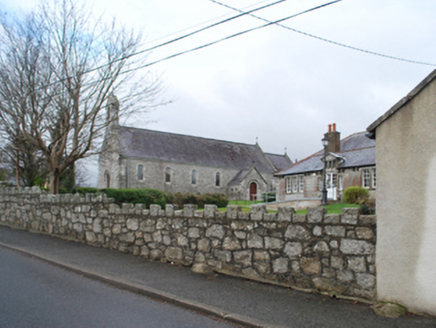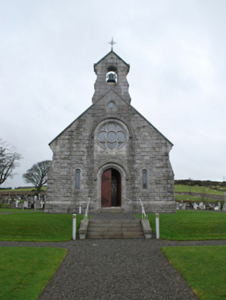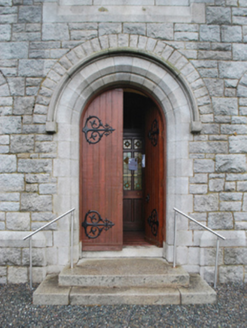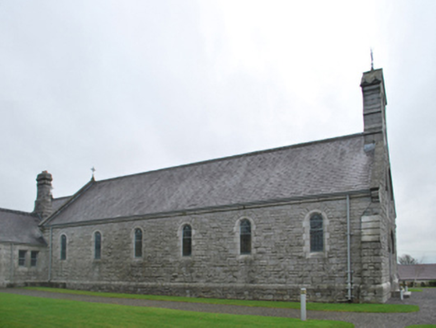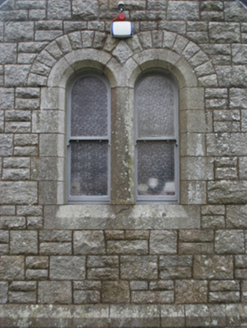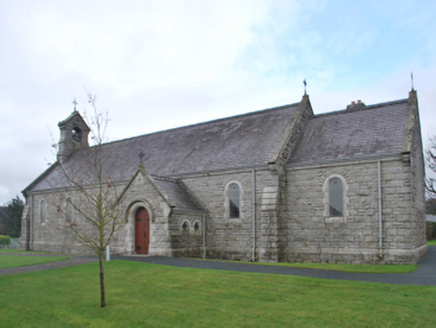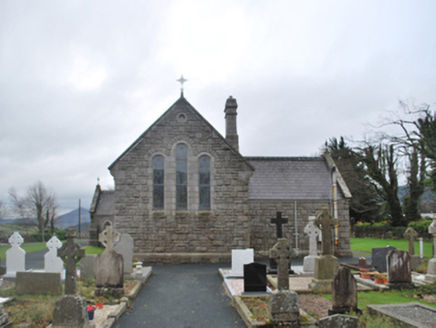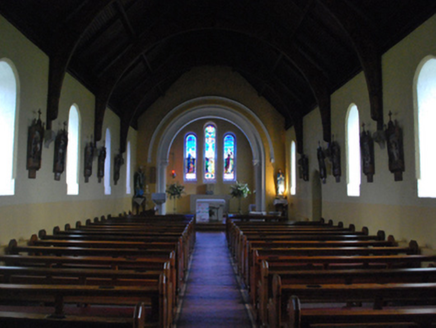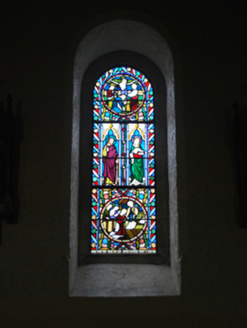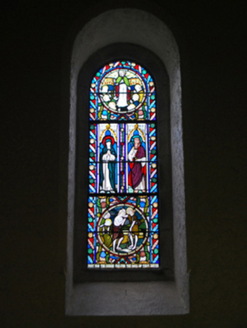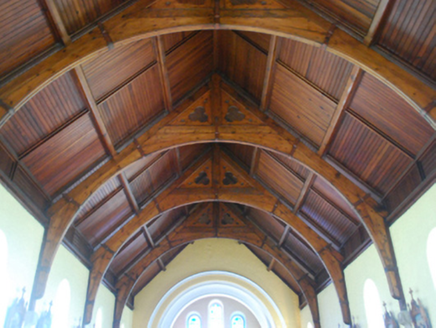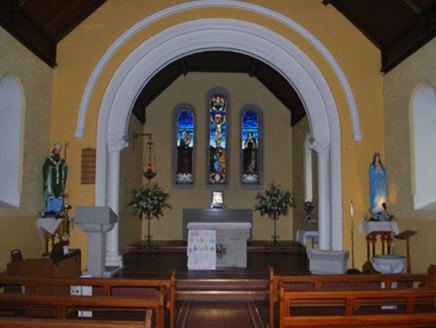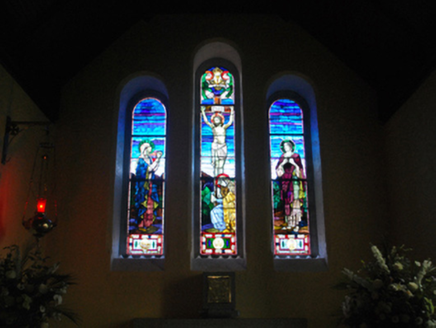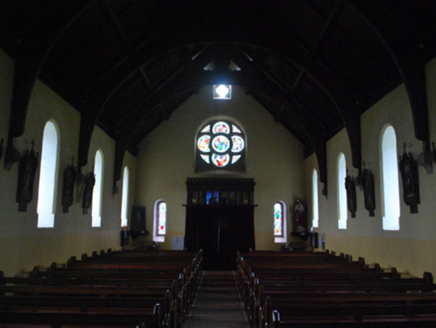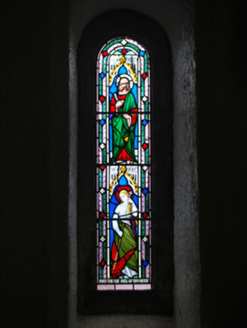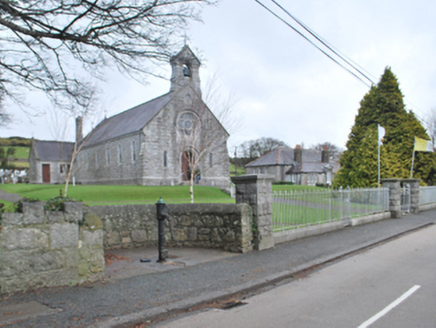Survey Data
Reg No
60250023
Rating
Regional
Categories of Special Interest
Architectural, Artistic, Historical, Social, Technical
Original Use
Church/chapel
In Use As
Church/chapel
Date
1905 - 1910
Coordinates
319212, 220630
Date Recorded
26/11/2012
Date Updated
--/--/--
Description
Detached seven-bay double-height Catholic church, built 1908-9; dedicated 1909, on a rectangular plan comprising six-bay double-height nave opening into single-bay double-height chancel (north). Renovated with sanctuary reordered. Pitched slate roofs with perforated crested clay ridge tiles, cut-granite coping to gables on cut-granite ogee corbel kneelers with wrought iron Cross finials to apexes, cut-granite coping to gable to entrance (south) front on cut-granite ogee corbel kneelers with granite ashlar buttressed gabled bellcote to apex framing embossed cast-bronze bell, and cast-iron rainwater goods on cut-granite eaves retaining cast-iron downpipes. Tuck pointed coursed or snecked rock faced granite battered walls on cut-granite chamfered cushion course on coursed or snecked rock faced granite plinth with drag edged rock faced cut-granite buttresses to corners having cut-granite "slated" coping. Round-headed window openings with cut-granite block-and-start surrounds having chamfered reveals framing storm glazing over fixed-pane fittings having square leaded glazing bars. Round-headed "Trinity Window" to chancel (north) with cut-granite block-and-start surround having chamfered reveals framing storm glazing over fixed-pane fittings having leaded stained glass panels. Round-headed door opening to entrance (south) front with two cut-granite steps, cut-granite block-and-start surround having chamfered reveals with hood moulding on monolithic label stops framing timber boarded or tongue-and-groove timber panelled double doors. Quatrefoil "Rose Window" (gable) in round-headed recess, cut-granite block-and-start surround having chamfered reveals with hood moulding on monolithic label stops framing storm glazing over fixed-pane fittings having leaded stained glass panels. Interior including vestibule (south) with herring bone-pattern terracotta tiled floor; full-height interior open into roof with stained glass "Rose Window" (south), herring bone-pattern terracotta tiled central aisle between timber pews, paired Gothic-style timber stations between frosted glass windows, trefoil-perforated exposed round arch braced collared timber roof construction on cut-granite "Cavetto" corbels with wind braced timber boarded or tongue-and-groove timber panelled ceiling in carved timber frame on carved timber cornice, and round-headed chancel arch framing terracotta tiled stepped dais to sanctuary (north) reordered with replacement cut-granite altar below stained glass memorial "Trinity Window" (1925). Set in landscaped grounds on a slightly elevated site including terrace centred on flight of five cut-granite steps.
Appraisal
A church erected to a design signed (1909) by William Henry Byrne and Son (formed 1902) of Suffolk Street, Dublin (DIA), representing an important component of the early twentieth-century built heritage of south County Dublin with the architectural value of the composition, one recalling the Byrne-designed Saint Mary's Catholic Church (1911-3), Bofeenaun, County Mayo, confirmed by such attributes as the compact rectilinear plan form, aligned along a liturgically-incorrect axis; the rock faced surface finish offset by sheer Barnaculia granite dressings not only demonstrating good quality workmanship, but also producing a steely two-tone palette; the slender profile of the openings underpinning a streamlined Romanesque theme with the chancel defined by an elegant "Trinity Window"; and the handsome bellcote embellishing the roofline as a picturesque eye-catcher in the landscape. Having been well maintained, the elementary form and massing survive intact together with substantial quantities of the original fabric, both to the exterior and to the interior reordered in accordance with the liturgical reforms sanctioned by the Second Ecumenical Council of the Vatican (1962-5) where contemporary joinery; and the vibrant Rafferty Memorial "Trinity Window" donated (1925) by Sister Mary Rafferty (d. 1966), all highlight the artistic potential of the composition: meanwhile, an exposed timber roof construction pinpoints the engineering or technical dexterity of a church forming part of a neat self-contained group alongside the nearby Saint Patrick's Catholic Chapel (1824; see 60250025) with the resulting ecclesiastical ensemble making a pleasing visual statement in a rural village street scene.
